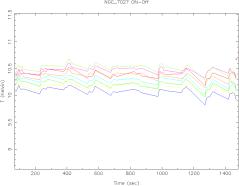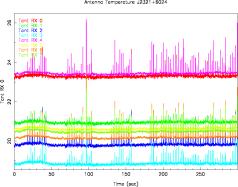 Figure 3. Expanded view of Figure 2.
Figure 3. Expanded view of Figure 2.
This shows an expanded view of the noise in a signal-free part of the scan. Again, the rms noise is of the order of 50 mK.
This is a test of multiple IF wide-band continuum capability. This is the first time someone has proposed to use this capability. Test observations done at 5 Ghz on October 21 are reported here.
The bottom line: overcast weather conditions during these tests prevent the goals of the project from being met. The rms noise on a series of ON/OFF scans of a calibration source was about 100 times the theoretical rms predicted by the radiometer equation. This should be tested again during clear weather.
The system was set up with 4 spectral windows, 2 linear polarizations each. Thus there were 8 IFs recorded of 200 MHz bandwidth each, by the DCR (digital continuum receiver).
The aips++ dcr tool identifies the IFs with "Receptor numbers" as follows:
| Receptor # | Center Frequency | Pol | Receptor # | Center Frequency | Pol | |
|---|---|---|---|---|---|---|
| rx 0 | 4.7 GHz | X | rx 4 | 4.7 GHz | Y | |
| rx 1 | 4.9 GHz | X | rx 5 | 4.9 GHz | Y | |
| rx 2 | 5.1 GHz | X | rx 6 | 5.1 GHz | Y | |
| rx 3 | 5.3 GHz | X | rx 7 | 5.3 GHz | Y |
A series of 10 ON/OFF scans were done on calibrator NGC7027,
whose flux density is about 5.5 Jy at 5 GHz.
For this series, the integration time was 10 seconds.
The 3K noise cal was switched on and off at 10 Hz.
Each scan was 60 seconds long, i.e, there were 6 integrations
recorded per scan.
The data were scaled to temperature units.
For each on-source scan, the average of the two adjacent off-source
scans was subtracted.
 Figure 1. NGC 7027 Antenna Temperature vs time.
Figure 1. NGC 7027 Antenna Temperature vs time.
The corresponding statistics are listed in the following table:
RX mean on-off rms(K) -- ---------- ------- 0 10.40 K 0.0637 1 10.21 0.0679 2 10.07 0.0703 3 10.28 0.0711 4 10.47 0.0553 5 10.16 0.0641 6 10.36 0.0746 7 10.51 0.0771As one can see, the rms is about 70 mK, but the theoretical rms noise that one calculates from the radiometer equation for a 200 MHz band, 10 second on/off integrations, and 25K system temperature, is about 0.6 mK. Thus the measured rms noise is about 100 times the expected. The weather was overcast, so perhaps what we are seeing is atmospheric fluctuations.
 Figure 2. A five-minute scan of pulsar J2321+6024
Figure 2. A five-minute scan of pulsar J2321+6024
 Figure 3. Expanded view of Figure 2.
Figure 3. Expanded view of Figure 2.
This shows an expanded view of the noise in a signal-free
part of the scan. Again, the rms noise is of the order of 50 mK.